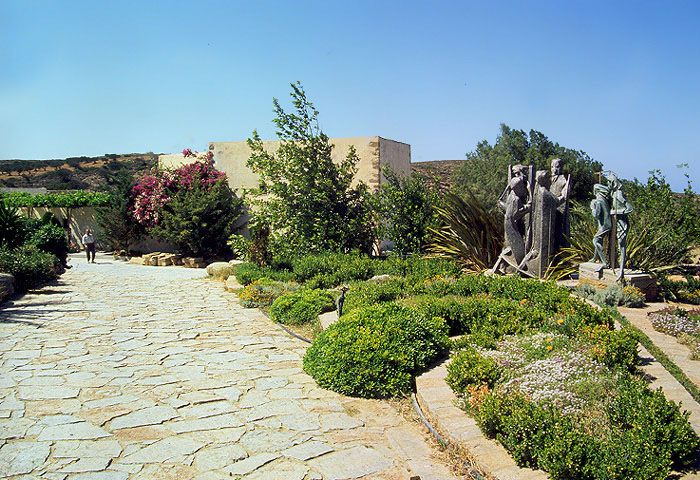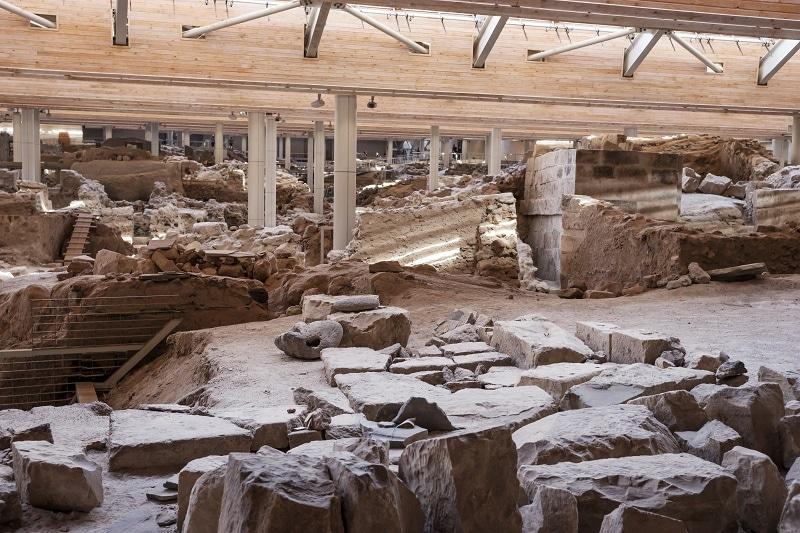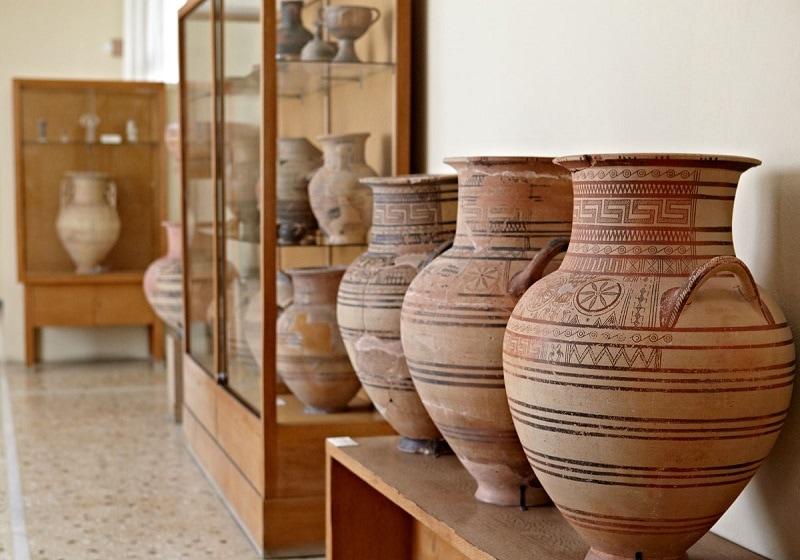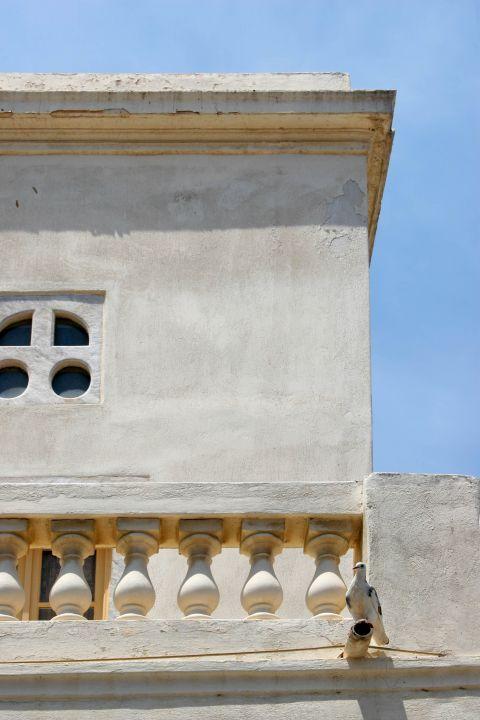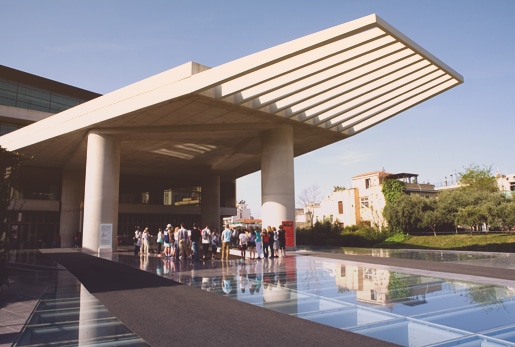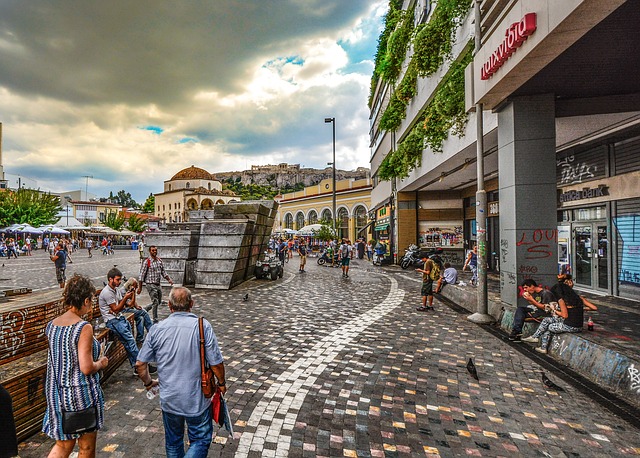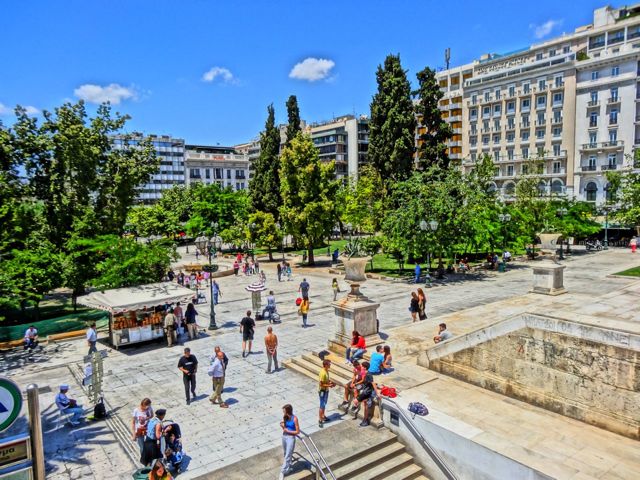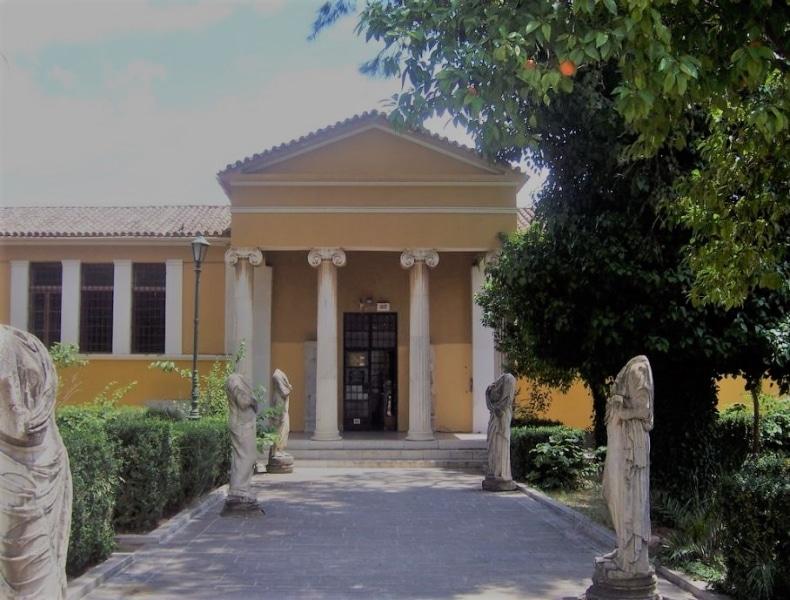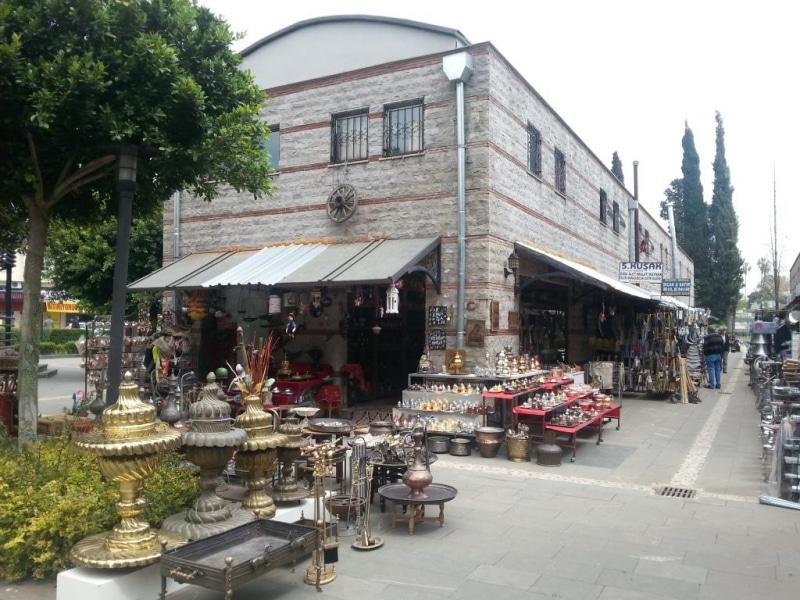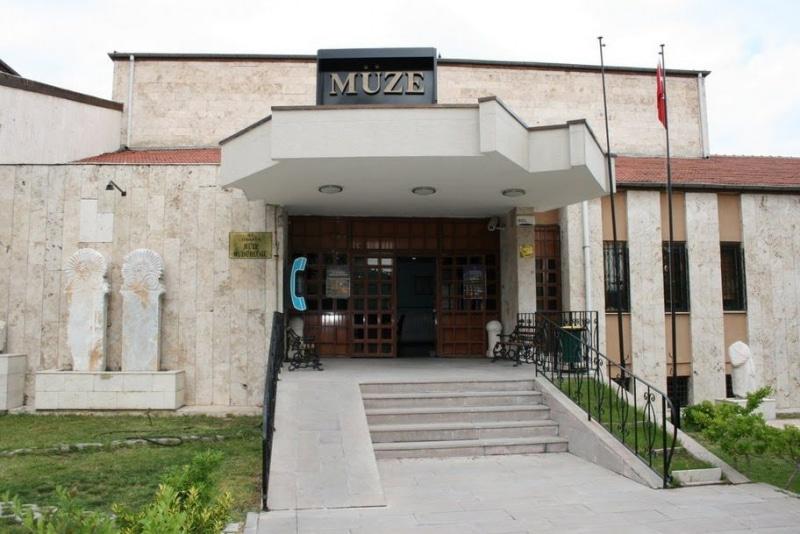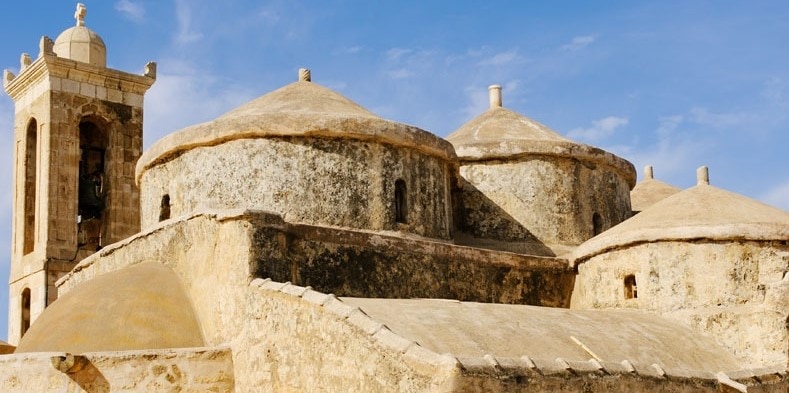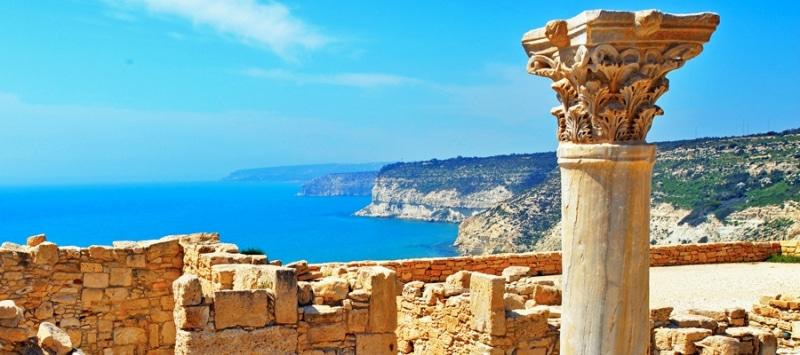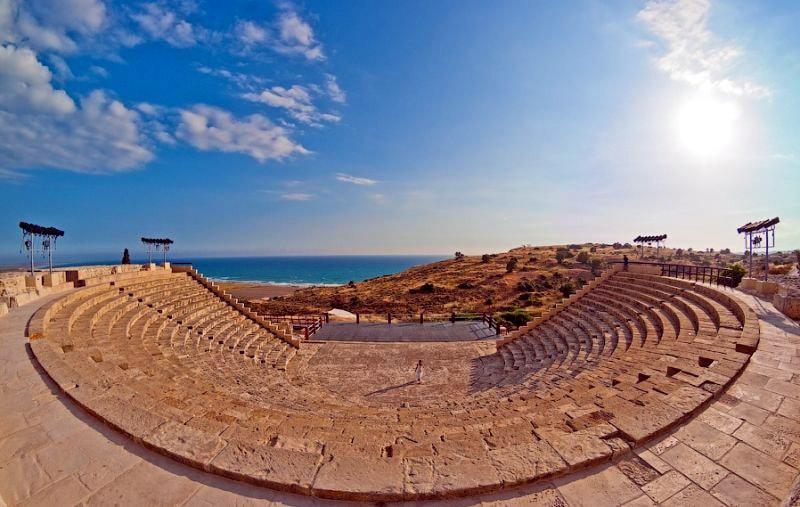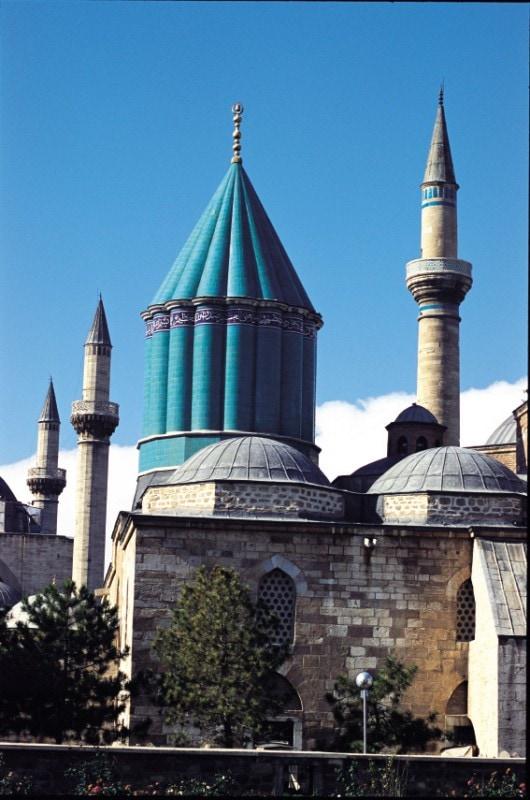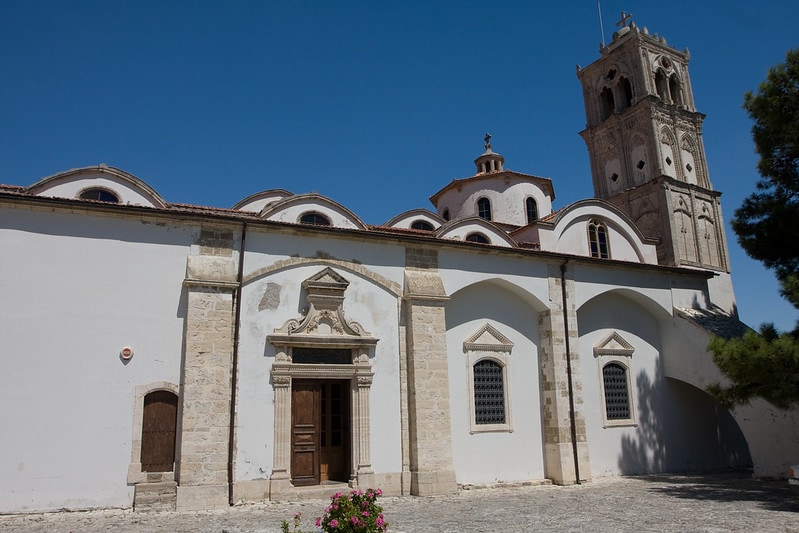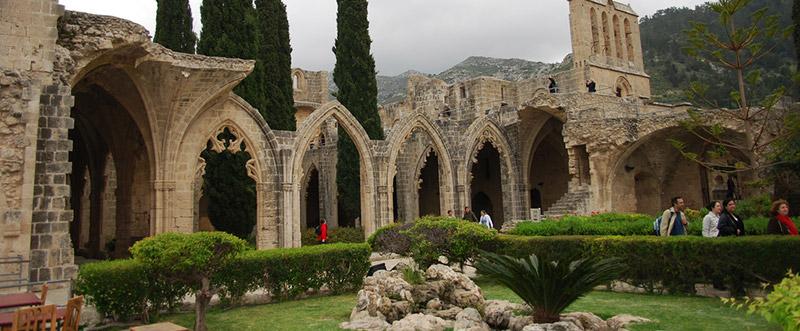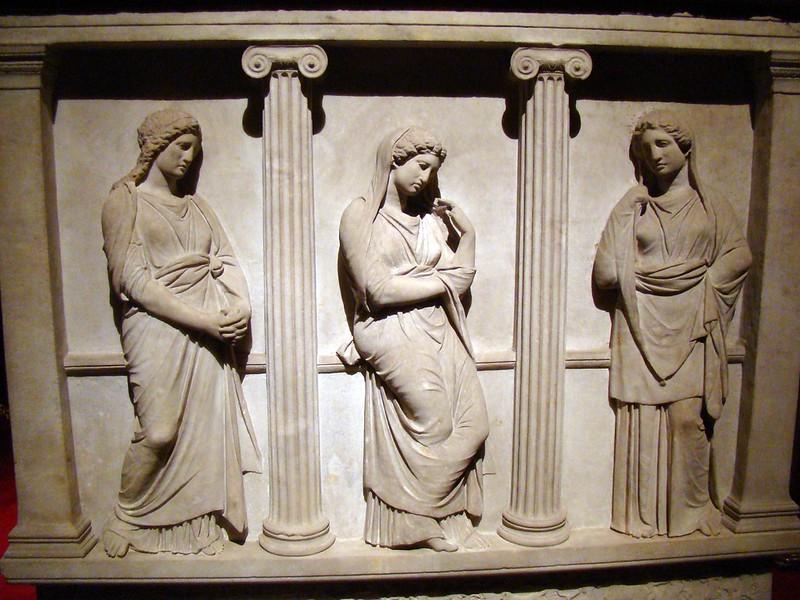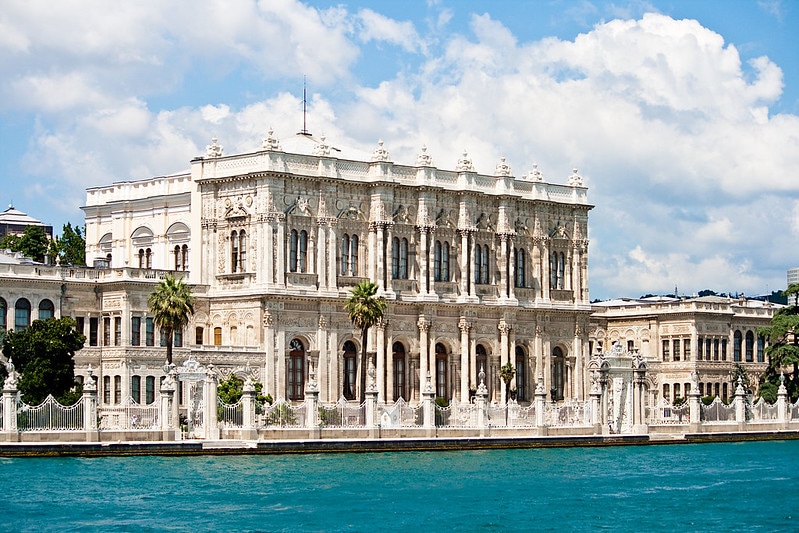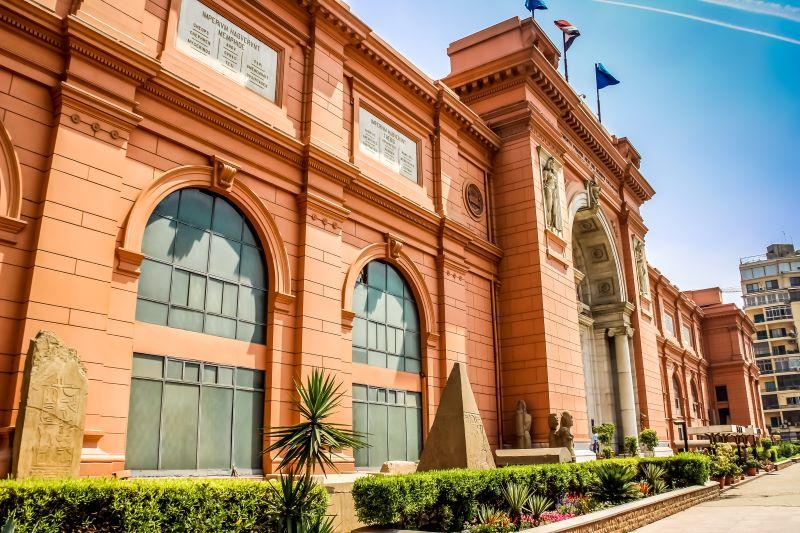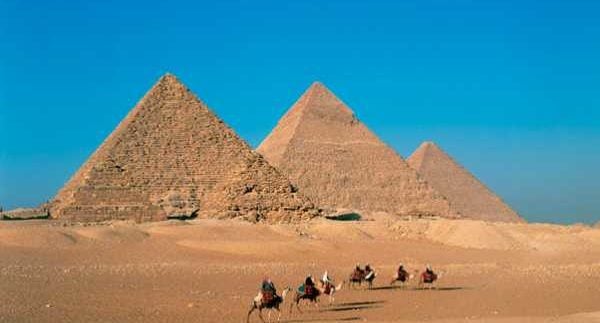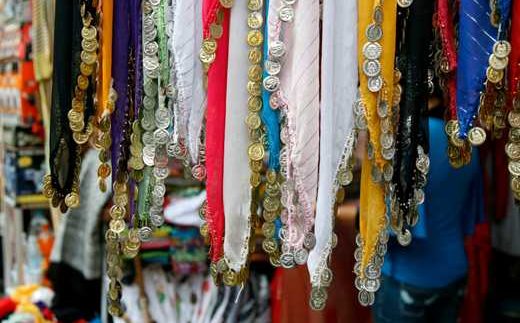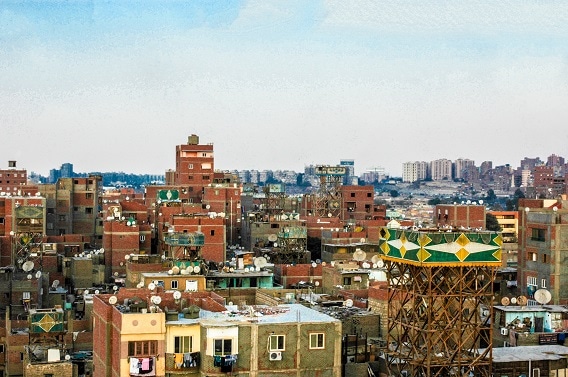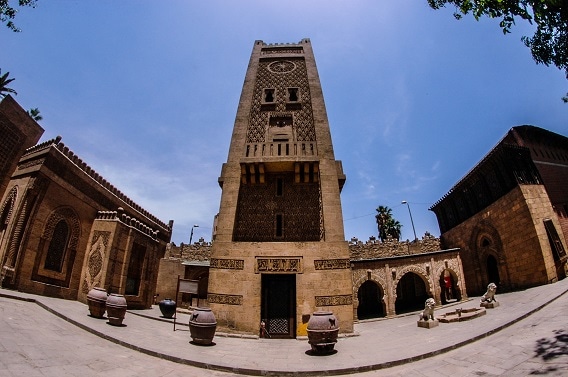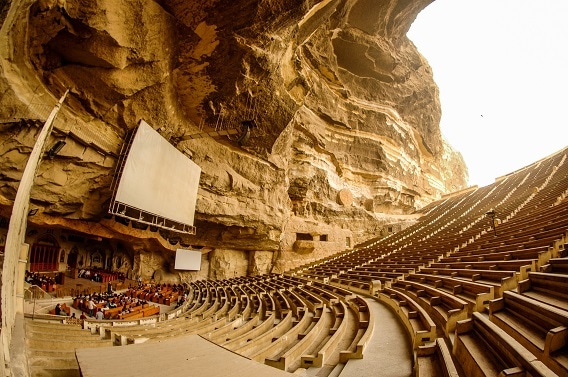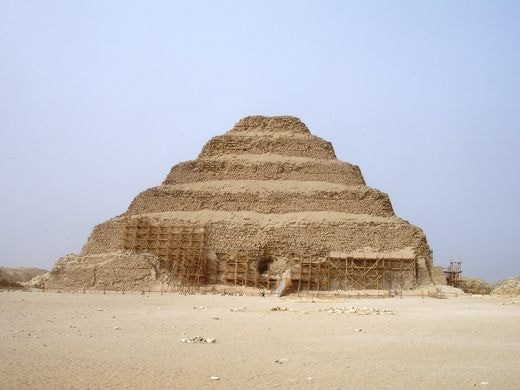ArtandCulture, Sitia
Removed from Unnamed collection
Archaeological Museum
The long archaeological and historical research at the Sitia area has brought to light rare and valuable finds and information of all civilizations from the Neolithic Age and the Minoan period to the New Age. The civilizations that have flourished the grounds of Sitia, one of the richest areas in archaeological sites internationally have bequeathed us magnificent samples of material and intellectual wealth that are exhibited in the district Museums and Collections. http://www.visitsitia.gr/en/sights/SitePages/view.aspx?nID=89
Map
Explore more places related to this search:
Removed from Unnamed collection
Akrotiri
The most prominent archaeological site in Santorini is Akrotiri and the findings of the excavations that began in 1967. Akrotiri (Promontory) is located at the southwestern tip of the island, 15 km from Fira. It is a real promontory, with sheer cliff shores stretching three miles west of the southernmost part of Santorini.
First signs of habitation in Akrotiri date back to the Late Neolithic Period (at least from the 4th millennium BC). By the Early Bronze Age (3rd millennium BC), there was a settlement in Akrotiri that was expanded in the Middle and Late Bronze Age (20th-17th centuries BC) becoming one of the main urban centres of the Aegean.
Covering about 50 acres, the settlement had a very well-planed infrastructure and an elaborate sewage system. Imported products found inside the buildings prove that Akrotiri was well developed, held strong ties with Minoan Crete and conducted business with the Greek mainland, the Dodecanese, Cyprus, Syria, and Egypt. The growth of the town ended abruptly at the end of the 17th century BC, when its inhabitants left due to powerful seismic foreshocks. Then, the volcano erupted, and volcanic material covered the town and the rest of the island, preserving the buildings and their contents to this day.
This unique site gives visitors the opportunity to admire and walk through the sheltered settlement! http://www.santorini.gr/index.php?option=com_content&view=article&id=167&Itemid=78&lang=en
Map
Removed from Unnamed collection
Archaeological Museum
The museum is in Fira. Its collections include sculptures and inscriptions ranging from the Archaic to the Roman period, as well as pottery artifacts and clay figurines from the Geometric up to the Hellenistic period. The most important exhibits are the Theraic jar with the geometric patterns dated from the early 7th century BC; the large volcanic rock (trachyte) weighing 480 kilos; and many findings from the excavations at the cemetery of ancient Thera, such as jars and pottery, as well as kouros statues.
Standing at the centre of Fira, the Archaeological museum reveals the island's long history. The current building near the cable car terminal, was constructed in 1960 to replace the one that had collapsed during the earthquake of 1956. http://www.santorini.gr/index.php?option=com_content&view=article&id=100&Itemid=80&lang=en#prettyPhoto
Map
Removed from Unnamed collection
Archaeological Museum of Kos
The two storey bulding on Eleftherias Square that houses the Archaeological museum of Kos is a protected monument of the Italian occupation era (1912 - 1943), built in 1935. http://www.kos.gr/en/sights/SitePages/view.aspx?nID=20
Map
Removed from Unnamed collection
Municipal Library of Mykonos
The Municipal Library of Mykonos is housed in a magnificent old mansion that belonged to the Mavrogenis family. Dated to 1735, this beautiful building has seen its own share of history. Located in Agia Kyriaki Square, it houses nearly 6,000 volumes of literature, history and many more categories, though most of the books are in Greek. You can travel through the library looking at numerous photographs as well as Cycladic coins and old seals.
The books were donated by a Mykonian historian, Ioannis Meletopoulos, from his own personal library. Other books were also donated by many more people from their own libraries, while some other donated other things as well, such as black and white sketches of landmarks on the island.
As of now, with the advent of modernity, the municipal library is no longer operational. But they continue to be a symbol of Mykonos rich virile past. Being hundreds of years old, most of the municipal library has been thoroughly renovated and some have even been converted into museums, the most famous being the Bonis Windmill. Providing interesting insights into the life of Mykonos, all the works displayed in the library are unique and extremely interesting. A visit to this wonderful library is worth your time and effort. https://www.greeka.com/cyclades/mykonos/sightseeing/category-museums/municipal-library/
Map
Removed from Unnamed collection
Kadifekale
The city, which was founded in the 4th century BC, has remnants of Helen, Roman, Byzantine and Ottoman periods. Kadifekale is on a hill 186 meters high south of the city. It is reported that Amazon women who lived in Kadifekale, formerly "Pagos", descended from the foothills of the mountain and continued their dominance here for many years. http://www.izmirkulturturizm.gov.tr/TR,77369/kadifekale.html
Map
Removed from Unnamed collection
Acropolis Museum
Listed in the world’s top 20, the new Acropolis Museum is home to unique masterpieces, mainly from the Archaic and Classical periods. All exhibits are directly connected to the Acropolis and offer panoramic views of the monument from the museum’s halls. http://www.thisisathens.org/explore/venues-attractions/museums-monuments/museums-monuments/?Id=39
Map
Removed from Unnamed collection
Plaka neighborhood
The “core” of the historic centre is the Plaka neighborhood (at the eastern side of the Acropolis), which has been inhabited without interruption since antiquity. When you walk through the narrow labyrinthine streets lined with houses and mansions from the time of the Turkish occupation and the Neoclassical period (19th c.), you will have the impression of travelling with a “time machine” http://www.visitgreece.gr/en/main_cities/tour_in_the_historic_center_of_athens
Map
Removed from Unnamed collection
Syntagma Square
Syntagma Square is the most famous in Athens if not all of Greece. No matter where you have to go in Athens, if you can find Syntagma Square you can find your way there.
Syntagma Square is back and better than ever. Well maybe not better than ever. It was probably at it's best in the early 1900's when there were not cars and buses whizzing around it and it was shaded by large trees. But with the re-routing of the traffic, the opening of the new metro and the removal of the wooden billboard covered walls that for at least an entire year, hid the construction site that was once Athens most popular platia, Syntagma looks better than it has in many years. At the top of the square are two stairways and an elevator leading to the Syntagma Metro Station, one of the most beautiful metro stations in the world, with its own museum of artifacts found at the construction site. https://www.athensguide.com/syntagma.html
Map
Removed from Unnamed collection
Sacred Rock of the Acropolis
The Sacred Rock of the Acropolis "the province of the Gods", unoccupied by humans, is a perfect 5th century BC collection of public monuments which stands as a unique Greek testimony. http://www.thisisathens.org/explore/venues-attractions/12-attractions/sacred-rock-of-the-acropolis/
Map
Removed from Unnamed collection
Monastiraki
Monastiraki is one of the most renowned neighborhoods in central Athens partly because it belongs to the oldest part of the town and due to its traditional flea market. A vivid neighborhood with the aromas and arts of a bygone era still prominent! http://www.thisisathens.org/explore/venues-attractions/12-attractions/monastiraki-kerameikos/
Map
Removed from Unnamed collection
Archaeological Museum of Sparta
Today, the Archaeological Museum of Sparta hosts thousands of finds from the province of Lacedaemon, but also from areas of the prefecture of Laconia that are not covered by the Archaeological Collections of Gythio and Neapoli Vion. In its rooms are exhibited findings that cover the time period from the Neolithic to the late Roman era. The most important place is occupied by the findings of the great sanctuaries of Sparta. The visitor of the museum has the opportunity to admire findings from the most important prehistoric sites of Laconia, sculpture works from the Archaic years to the Roman, coming from various areas of the prefecture, as well as findings from the rescue excavations among which have a prominent place, the sections of mosaic floors of Roman times from Sparta. Today, in the seven rooms of the museum (about 500 sq.m.) only a small part is exhibited, part of the numerous finds housed in it and which continue to come to light daily from the excavations of the Ephorate of Prehistoric and Classical Antiquities in the area. of Sparta but also in other areas of Laconia. Due to lack of space, only a small part of the findings kept in it, the most interesting for the scientific community or the ordinary visitor, have been included in its report.
The Archaeological Museum of Sparta belongs to the 5th Ephorate of Prehistoric and Classical Antiquities. http://odysseus.culture.gr/h/1/gh151.jsp?obj_id=3305
Map
Removed from Unnamed collection
Fikret Otyam, Ironsmiths Exhibition and Art Gallery
Fikret Otyam, Ironsmiths Exhibition and Art Gallery was opened in 2013 to provide a center of excellence where skilled artisans and craftsmen could work and display their trade and craft and provide an insight into the metalworking world to the general public. http://antalyacentral.com/attractions/fikret-otyam-blacksmiths-art-gallery
Map
Removed from Unnamed collection
Isparta Museum
A must in Isparta is the Isparta museum. Here you can see excavations from the Persian, Ottoman and Roman times. The museum has four halls: archeology, excavations, ethnography and carpets. https://www.nederlandersinturkije.nl/bezienswaardigheden/isparta-muzesi-museum/
Map
Removed from Unnamed collection
Paphos Archaeological Museum
The Pafos District Archaeological Museum houses a collection of finds from the Pafos (Paphos) region dating from the Neolithic Age to 1700 AD.
The exhibits are set across five rooms and originate mainly from Palaipafos (Kouklia), Nea Pafos (present day Pafos) and Marion-Arsinoe (Polis). They are supplemented by finds from Pegeia, Kissonerga, Lempa, Pano Arodes, Salamiou, Akourdalia, Pomos, Kidasi and Geroskipou.
The first room covers the Neolithic, Chalcolithic and Bronze Age, including coins cut from the mint of Pafos. The second room houses exhibits from the Iron Age and Classical period, including a tombstone from Marion with the Cyprosyllabic script. The third room presents the Hellenistic and Roman periods, with a rare marble bust of Aphrodite and a marble statue of Asklepios. The fourth room hosts exhibits from the late Roman and early Christian periods, while the newer fifth room showcases pieces from the Byzantine Period and the Middle Ages in general. https://www.visitcyprus.com/index.php/en/discovercyprus/culture-religion/museums-galleries/item/156-archaeological-museum-of-the-pafos-paphos-district
Map
Removed from Unnamed collection
Agia Paraskevi Church
Located in the village of Geroskipou, this interesting 9th century Byzantine church is a five-domed, three-aisled, barrel-vaulted basilica, making it one of only two such churches on the whole island, and a significant example of Byzantine architecture.
The beautiful interior wall paintings date to various periods, from the 8th-15th centuries. A monochrome reddish cross, painted directly on the stone, is of an earlier type and was revealed during restoration works. This type of cross is usually dated to the Early Christian period, up until the 8th-9th century.
Apart from its frescoes, the church also contains a rather significant portable, double-sided icon, dating to the 15th century. The Virgin Mary is depicted on one side, and the scene of the Crucifixion on the other.
According to tradition, the name Geroskipou (‘sacred garden’ in Greek) derives from the sacred gardens of the Goddess Aphrodite, which were located to the south of the village towards the sea, at the point where the ancient pilgrims began their journey to the sanctuary of Palaipafos (old Pafos). As such, the church may stand on the ruins of an ancient temple dedicated to Aphrodite, although it could also originally have been dedicated to Timios Stavros (the Holy Cross). Today, it is dedicated to the Christian martyr Agia Paraskevi. https://www.visitcyprus.com/index.php/en/discovercyprus/rural/sites-monuments/item/700-agia-paraskevi-byzantine-church-geroskipou-village
Map
Removed from Unnamed collection
Kourion Archaeological Site
The archaeological remains of Kourion - which was one of the island’s most important city-kingdoms in antiquity - are of the most impressive on the island, and excavations have unearthed many significant finds, which can be viewed at the site. http://www.visitcyprus.com/index.php/en/discovercyprus/rural/sites-monuments/item/2402-kourion-archaeological-site
Map
Removed from Unnamed collection
Kourion Ancient Amphitheater
One of the most beautiful and interesting for visiting amphitheatres is located in Kourion. It will amaze travellers with its majestic appearance, the beauty of the preserved antique mosaics and the magnificent panoramic view that opens from spectators’ seats. http://www.orangesmile.com/extreme/en/operational-amphitheaters/ourion-ancient-amphitheater.htm#object-gallery
Map
Removed from Unnamed collection
Mevlana Museum
Mevlevi Derhgahı (Dervish Lodge) and the mausoleum started to function as a museum in 1926 under the name of Konya Museum of Historical Works. In 1954 the display pattern of the museum was once more taken up and it was renamed as the Mevlevi Museum. http://www.kultur.gov.tr/EN,113978/konya---mevlana-museum.html
Map
Removed from Unnamed collection
The Folk Art Museum
The visitors of Lefkara must not fail to see the Patsalos house. It houses the Museum of Popular Art and hosts exquisite embroidery samples, some of which date back to the 19th century. http://www.lefkaravillage.com/museums.html
Map
Removed from Unnamed collection
Timios Stavros Church
The magnificent Lefkara Church is dedicated to the Holy Cross and dates back to the 14th century. According to the byzantinologist Athanasios Papageorgiou, the eastern part of the Church dates back to the 14th century, named after considering rescued frescoes behind the church’s iconostasis. This date is also confirmed by the metrical “Olivianos’ inscription”, which appears at the bottom of the Lefkara Golden Cross. There is written evidence that Olivianos was a Lefkara Bishop in 1307 during the occupation period by the Franks. This fact is also confirmed undeniably by the founder’s note on a manuscript dating back to the 14th century, which is kept in the Church’s safe. At the end of this manuscript, which is a precious Evangeliary it is noted that it was written in 1345/46 and that the monk Gabriel who was the abbot and the founder of the “Holy and Life-giver Revealed Cross” monastery paid all the expenses. In 1740 the church was restored and the wooden sculptured iconostasis was then made by the Rhodian sculptor Hadjikyriacos who was called in by the church-warden Lourentzos to this end.
n 1867 important works were carried out in the church and it was, therefore, expanded in order to have a greater congregation capacity. In 1909 common repair works in the church were deemed necessary and then the entrance was constructed as it appears today. The south door was also built. In 1953 the dome was covered with paintings. The style of the eastern part of the church is cruciform with a cupola, while the style of its more recent part is Cypriot dating back to the 19th century. Furthermore, there are six internal pillars ranged in two rows per three pillars. http://www.lefkaravillage.com/churches.html
Map
Removed from Unnamed collection
Bellapais Abbey
Bellapais Abbey is located in the hillside, 6 miles South East of Kyrenia. The Abbey is the best example of Gothic architecture in Cyprus, as well as being ones of the finest in the Middle East. Built by the Lusignans, the first settlers in Bellapais Abbey were the Agustinas Monks, who escaped from Jerusalem in late Twelth century. http://www.kyreniacastle.com/kyrenia.php
Map
Removed from Unnamed collection
Istanbul Archaeological Museum
The Istanbul Archaeological Museums is among the most impressive historical venues for your outdoor events and made up of three main units: the Istanbul Archaeological Museum, the Ancient Orient Museum and Tiled Kiosk Museum. The collection of the Archaeology Museum Turkey’s first museum houses over one million artefacts belonging to various cultures collected from the imperial territories. The Archaeological Museum was founded on June 13, 1891, under the name of Müze-i Hümayun (the Imperial Museum). Commissioned by archaeologist, painter and curator. http://icvb.org.tr/venue/istanbul-archaeological-museums/
Map
Removed from Unnamed collection
Topkapi Palace Museum
It is located on the promontory of the historical peninsula in İstanbul which overlooks both the Marmara Sea and the İstanbul strait. The walls enclosing the palace grounds, the main gate on the land side and the first buildings were constructed during the time of Fatih Sultan Mehmet (the Conqueror) (1451 - 81). The palace has taken its present layout with the addition of new structures in the later centuries. Topkapı Palace was the official residence of the Ottoman Sultans, starting with Fatih Sultan Mehmet until 1856, when Abdülmecid moved to the Dolmabahçe Palace, functioned as the administrative centre of the state. The Enderun section also gained importance as a school.
Topkapı Palace was converted to a museum in 1924. Parts of the Palace such as the Harem, Baghdad Pavilion, Revan Pavilion, Sofa Pavilion, and the Audience Chamber distinguish themselves with their architectural assets, while in other sections artefacts are displayed which reflect the palace life. The museum also has collections from various donations and a library. https://www.ktb.gov.tr/EN-113953/istanbul---topkapi-palace-museum.html
Map
Removed from Unnamed collection
Dolmabahce Palace
Dolmabahce Palace built in 19 th century is one of the most glamorous palaces in the world. It was the administrative centre of the late Ottoman Empire with the last of Ottoman Sultans was residing there. After the foundation of the Turkish Republic in Ankara, Mustafa Kemal Ataturk transferred all government functions to the youthful capital but on his visits to Istanbul Ataturk occupied only a small room at Dolmabahce Palace as his own. He stayed, welcomed his foreign guests and made a practical centre for national, historical and language congress and for international conferences. http://www.dolmabahcepalace.com/
Map
Removed from Unnamed collection
Byzantine Art Museum
The Byzantine Art Museum (in Dexameni square), where artifacts from the Byzantine period are showcased; over 700 well preserved byzantine sculptures, murals, paintings and icons from temples from around the city. http://www.visitgreece.gr/en/main_cities/kastoria
Map
Removed from Unnamed collection
The Egyptian Museum
It may not be the oldest museum exhibiting Egyptian antiquities, but the Egyptian Museum holds the most: over 150,000 pieces are on display, with an incredible 30,000 more stocked away.
After an initial ID check at the Egyptian Museum’s entrance just off of Tahrir Square, there is a bag check at the main gates. Once you have acquired your ticket, there is yet another queue for ticket checks, before you enter through the museum doors, upon which you are subjected to another electronic sensor. Despite the museum’s website claims, you are not allowed to bring a camera in under any circumstances. Upon entering the museum, you will feel like a rogue archaeologist that has stumbled on a tomb of treasures.
You are immediately confronted by three routes. Taking a left will start you off on the chronological route through Egyptian history. Once you’ve figured out the slightly confusing numbering, room fourteen is a secret little pleasure and a must-see. Guarded by statues on either side of its entrance, the room is built like a temple. Steles are used to cover the walls, as a huge, inscribed pillar seems to hold up the ceiling of the museum itself. https://www.cairo360.com/article/arts-culture/the-egyptian-museum-an-insiders-guide/
Map
Removed from Unnamed collection
The Great Pyramids of Giza
There are three major pyramids in the pyramids necropolis in Giza. If you do not fear small spaces, take the opportunity to step inside the small cavity of the Great Pyramid (for a negotiable tip or fee) to experience the pyramid’s rather daunting descending staircase as well as the king’s and queen’s respective burial chambers.
The Great Pyramid of Khufu is believed to have been built over a twenty-year period and completed around the year 2560 B.C. For centuries, the Pyramid held the record as the tallest
man-made structure in the world. Besides the many theories and symbolism that it embodies, the Pyramid is one of the most breathtaking monuments of Ancient Egypt; take a trip to gaze at its peak and see for yourself.
Although not as magnificently large as the Great Pyramid of Khufu, the Pyramid of Khafra has a more complex interior and a large number of statues dedicated to Khafra, son of Khufu,
including the Sphinx.
The smallest of the three, the Pyramid of Menkara rarely gets the same attention as its two larger neighbours; as it lacks the size of Khufu and the Sphinx of Khafra. Menkara’s one advantage may be its material: the two predecessors used limestone, whereas Menkara used the more valuable and pricier granite in his burial chambers. https://www.cairo360.com/article/sights-travel/the-great-pyramids-of-giza-egypts-seventh-wonder-of-the-ancient-world/
Map
Removed from Unnamed collection
Khan El Khalili
There’s absolutely nothing in Cairo like exploring the enormous shopping labyrinth of Khan El Khalili, the city’s largest souk that has preserved much of its original structure since its days as a famous medieval bazaar. Tourists and Egyptians alike arrive at this densely populated maze of streets and alleyways to find all sorts of gifts, including Egyptian antiques, fine handmade crafts, shishas and spices. https://www.cairo360.com/article/sights-travel/cairo-guide-shopping-in-khan-el-khalili/
Map
Removed from Unnamed collection
City of the Dead
Even Cairo, a bustling capital city of 21 million or so people, has its secrets and obscurities, not least the City of the Dead. Located below Mokattam Hills in the south east of the city, the area is essentially a necropolis; but over the centuries it has evolved into a living, breathing organism of its own that has managed to reach a certain degree of self-sufficiency. Though considered a slum – and it’d be hard to argue that – it also stands as one monument to Cairo’s colourful history.
Running along the city from north to south, the strip is around 6.4km long.
The City of the Dead dates back to the Muslim conquest of Egypt in 642 AD, when Amr Ibn Al ‘as established a family graveyard at the foot of Mokattam. Many of the residents are said to have moved there to be close to deceased relatives.
It has been something of a touristic site for centuries, with the likes of Moroccan scholar, Ibn Batuta –widely considered to be one of the greatest travelers in history – having visited and written about it. https://www.cairo360.com/article/sights-travel/in-photos-the-eerie-beauty-of-the-city-of-the-dead/
Map
Removed from Unnamed collection
The Mosque of Muhammad Ali
Located on Rhoda Island in Cairo’s Manial district, the Prince Mohammed Ali Palace is unlike any historical site in the capital. Built by the uncle of King Farouk, Prince Mohammed Ali Tewfik, between 1899 and 1929, what makes the palace stand out – even next to anything you’ll find in Old Cairo, which sits a stone’s throw away across a branch of the Nile – is its unique fusion of Ottoman, Persian, art nouveau and late baroque inspirations.
Divided into five distinctly conceived and designed buildings which sit in the middle of a stunning Persian garden, the palace was as much a home to Mohammed Ali’s grand collection of art, furniture, clothing and medieval manuscripts as it was for him. Lending itself to a museum blueprint, the palace was handed over to the Supreme Council of Antiquities – a former branch of the Ministry of Culture – in 1955 and quickly became one of the most striking reminders of the Mohammed Ali dynasty. The palace is also home to one of the world’s most lavish collections of Oriental carpets and rugs, while the walls silk embroideries and portraits of royals. https://www.cairo360.com/article/sights-travel/in-photos-the-majestic-grandeur-of-mohammed-ali-palace/
Map
Removed from Unnamed collection
St.Samaan Church
It’s become something of a cliché – a sad one at that – but we’ve said it before and we’ll say it again: there’s much more to Egypt than Ancient Egyptian antiquities. Granted, the Zabaleen area of Mokattam receives its fare share of attention for its sheer uniqueness, but one particular feature often goes unnoticed – St. Samaan Church.
The church is named after Samaan Al Kharaz (Simon the Ranner), who, according to the tradition, performed a miracle in moving the mountain to help Abraam – Pope of the Egyptian Church – prove his faith to a Jewish grand vizier. The areas of the mountain around the church also feature a number of carvings. These carvings were done by a Polish artist in 1995 and was commissioned by the church’s founder, Samaan Ibrahim. In addition to the church itself – which can seat up to 1000 people – the monastery also include a library, children’s playground and a cafeteria. https://www.cairo360.com/article/sights-travel/in-photos-the-stunning-serenity-of-st-samaan-church/
Map
Removed from Unnamed collection
Pyramid of Djoser
Built as a tomb for the pharaoh Djoser (or Zoser), the Djoser Pyramid was constructed between 2630 BC and 2611 BC in Saqqara, Egypt. Although it is considered the world’s oldest intact large-scale stone monument, the ancient structure is often overshadowed by Egypt’s most famous pyramids.
The Djoser Pyramid stands 197 feet high and was built using 11.6 million cubic feet of stone and clay. Imhotep—a doctor, priest, and sculptor, among other titles and talents—is widely attributed as the pyramid’s architect. Initially, the structure was designed as a traditional, flat-roofed tomb called a mastaba, but Djoser wanted something bigger, something grander.
The pyramid was part of a larger 40-acre complex containing a courtyard, temples, and chapels, all enclosed inside a 30-foot wall. The entrance to the complex, as well as 13 fake doors, is built into the wall. The complex also includes a number of building facades, all of which served ritual purposes.
The pharaoh’s burial chambers are located deep within the pyramid, along with those of his 11 daughters. The burial chamber is part of the pyramid’s winding, maze-like series of tunnels, which researchers think may have been designed to prevent theft (although the pyramid was eventually looted). https://www.atlasobscura.com/places/pyramid-of-djoser
Map
Removed from Unnamed collection
Velyans House
Velyan’s House in Bansko is located near the Holy Trinity Church and the central square of the town. The house is an example of the architectural style – fortified house of the Bulgarian Revival Period. Velyan’s House was built in the 18th century and was opened to visitors in 1977.
This was a modern two-story building made of stone and wood owned by a wealthy trade family with many children. After a sudden tragedy the family left the house. When the master-painter Velyan Ognev was invited come to Bansko to work on the decoration of the Holy Trinity Temple, the house was given to him by the local people as a symbol of gratitude. The master decorated its interior and exterior and transformed it into a genuine piece of art. With its hiding places, secret exits and fortified walls the Velanova kashta is a piece of legacy from the old times when Bulgaria was under Otoman rule and when people were supposed to hide and protect themselves by the numerous attacks by bandits at that time. http://bansko-guide.com/attraction/velyans-house-velyanova-kashta/
Map

